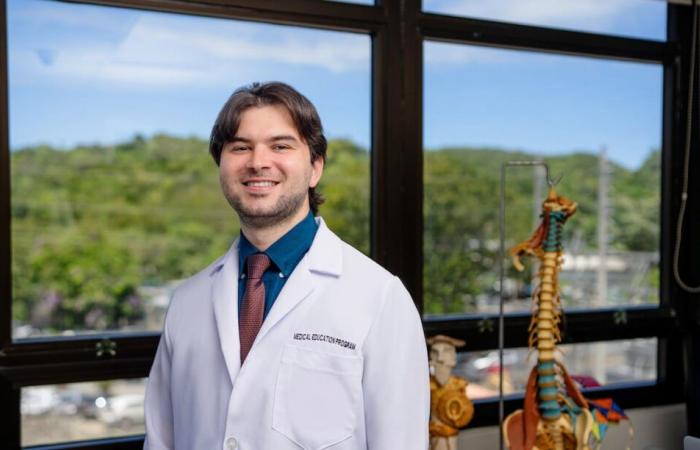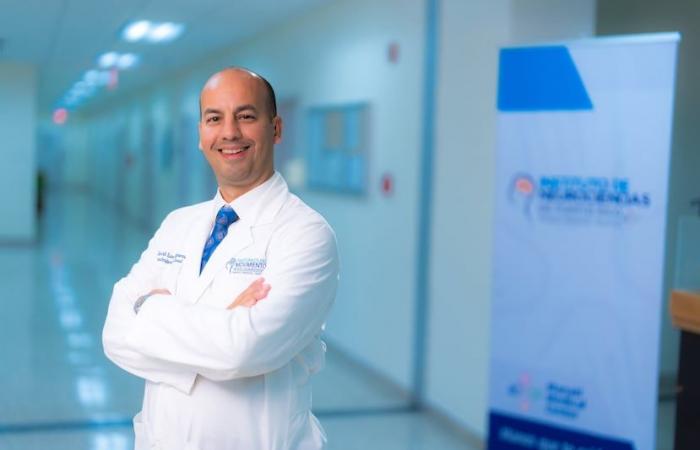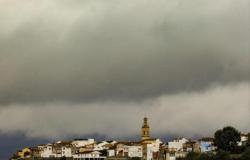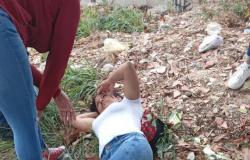At the end of a unique study on the island with professionals from the Institute of Neurosciences in Puerto Rico, which places Medical Center, the student of Medicine, Eduardo Pérez Luciano, expects the effort to inspire doctors and students to bet on the realization of clinical research in the country.
“For me, this project represents an attempt to promote research and arouse the hunger of medicine students to do important research projects within our island,” said Pérez, 27 years old and a neighbor of San Juan, who hopes to graduate from the Ponce Health Sciences university in 2026.
Research sought to demonstrate the safety and efficacy of deep brain stimulation surgery in patients operated in Puerto Rico with Parkinson’s disease and other movement disorders, such as essential tremor and dystonia (involuntary and sustained contraction of muscles).
This type of surgery, according to the Mayo Clinic, is to implement, within some areas of the brain, electrodes that produce electrical impulses. The electrodes are connected, by means of a cable under the skin, to a device that is placed near the clavicle. Electrical impulses impact brain activity and serve to treat several conditions.
In general, this intervention is recommended for patients who, even if they have very high doses of medicines, fail to experience significant improvement, explained the functional neurosurgeon David Lozada, director of the section of movement disorders of the Institute of Neurosciences of Puerto Rico and the only one on the island that performs the deep brain stimulation surgery.
“The purpose of surgery is not to cure, but to give quality of life to patients in stages where they are quite incapacitated,” Lozada explained. “It helps them control the tremor, rigidity and slow movement. It also manages to postpone the progress of the disease.”
About the study, Pérez explained: “We did what is called a record review. We took 207 patients who had operated deep brain stimulation from 2015 to 2022, evaluated those medical records and saw what complications arose during and after surgery. We look at both surgery reports and medical files and also evaluate the risk factors that each patient had before the intervention. ”
The 207 patients were subject to 370 operations done by Dr. Lozada at the Manatí Medical Center. The neurosurgeon clarified that the difference between the number of operated people and surgeries performed is because there are patients who require two interventions: one in each hemisphere of the brain.
During the year he dedicated to this research, Pérez worked at all stages of the process, from the conceptualization of the study and formulation of the methodology, to the project administration, writing of the original draft and edition of the manuscript. He did it from Lozada and the neurologists specializing in movement disorders, Laura Surillo and Ángel Viñuela, who work in the institute and appear as co -authors of the study.

The research concluded that all types of complications (such as seizures, intracranial hemorrhages and infraclavicular bruises, among others) obtained rates below 5 %. “It is a low percentage compared to existing medical literature on this type of intervention,” said the student.
In addition, he found that there was no increased risk of surgery complications in patients who had one or more risk factors such as diabetes, hypertension, obesity, anxiety, depression or smoking. Another significant finding is that there was no mortality in any of the 207 operated patients.
“This study has relevance for our patients with movement disorders because we have data verified by other scientific peers that confirm that, despite being an invasive surgery, it is safe and the complications rates are low,” said Pérez.
“There was no published data of this type of surgery in Puerto Rico, so we are the first to disseminate how the experience of this surgery on the island has been,” said the student.
In Surillo’s opinion, disseminating these results helps institute doctors to evaluate the work done with patients with deep brain stimulation surgeries and see how they can improve. “Doctors from the rest of the country are used to see the risks and benefits of referring to their patients to perform this operation,” added the neurologist.
Pérez said that the experience of working in a clinical investigation in Puerto Rico was enriching, allowing him to develop his skills and skills as a researcher, while exposed to the neurosurgery that are performed in the institute and the patients who are treated there. The opportunity was unique, since, according to Pérez, it is unusual for a medical student to do a year of research or a Fellowship Research on the island.
“It was an opportunity that I wanted to contact Dr. Jorge Lastra, director of the Institute and the Department of Neurosciences of Manatí Medical Center, for suggestions of my colleagues from the University,” the student recalled.
The idea arose when, at the end of his third year of Medicine studies, Pérez felt that he needed more experience focused on neurology and psychiatry, areas in which he wants to specialize in the future.
“I had the daring to write an email to Dr. Lastra explaining my idea of doing a year of research in your institution. The next day he called me and gave me all the details to join the team, ”said the student, who paused his studies for a year to devote himself fully to the investigative work.
Although Pérez is the first student to dedicate a year to investigations in The Puerto Rico Institute of Neurosciences, the institution – where 16 neuroscience professionals work – already had other initiatives aimed at arouseing interest in research and health industry. These initiatives include three programs: one for students of public and private schools, one for university students and one for medical students.
In the first, higher school students spend two weeks of summer at the Manatí Medical Center taking talks and making group rotations with different doctors, specialists and health professionals, Lozada said. In the second, each university chooses the specialty that interests him and, for a week, makes rotations related to that area within the hospital. Rotation is a period in which students spend time in a hospital department to acquire practical experience. In the third, medical students spend two months of summer, they are integrated into the research work of the Institute.
“The idea is to educate and create that curiosity and motivation for neurology to have more professionals in this area in the country,” said Surillo. He added that the Institute combines research and teaching with the offer of neurology services to adults and children, including neuropsychology, neurosurgery, neurorradiology and an comprehensive epilepsy unit, among others.
To continue educating, Pérez and Lozada will present the results of the study during the world Congress on Parkinson’s disease and related disorders, which will be held from the next May 7 in New York. There, it will be exhibited as poster, where it will be seen by different specialists in movement disorders around the world. “We want this to open the door to continue investigating in Puerto Rico and in Latin America this type of surgery and the treatment continues to expand,” said the student.
He added that his research experience with the Institute will not only help him prepare to be a neuropsychiatrist in the future, but he hopes that the doors opened to other young people interested in working clinical research on the island.
“We already have students interested in doing something similar to Eduardo in the following years,” Lozada said. “In Puerto Rico we have enough patients and results to publish the good things we do here.”
The author is a healthy Puerto Rico journalist.







